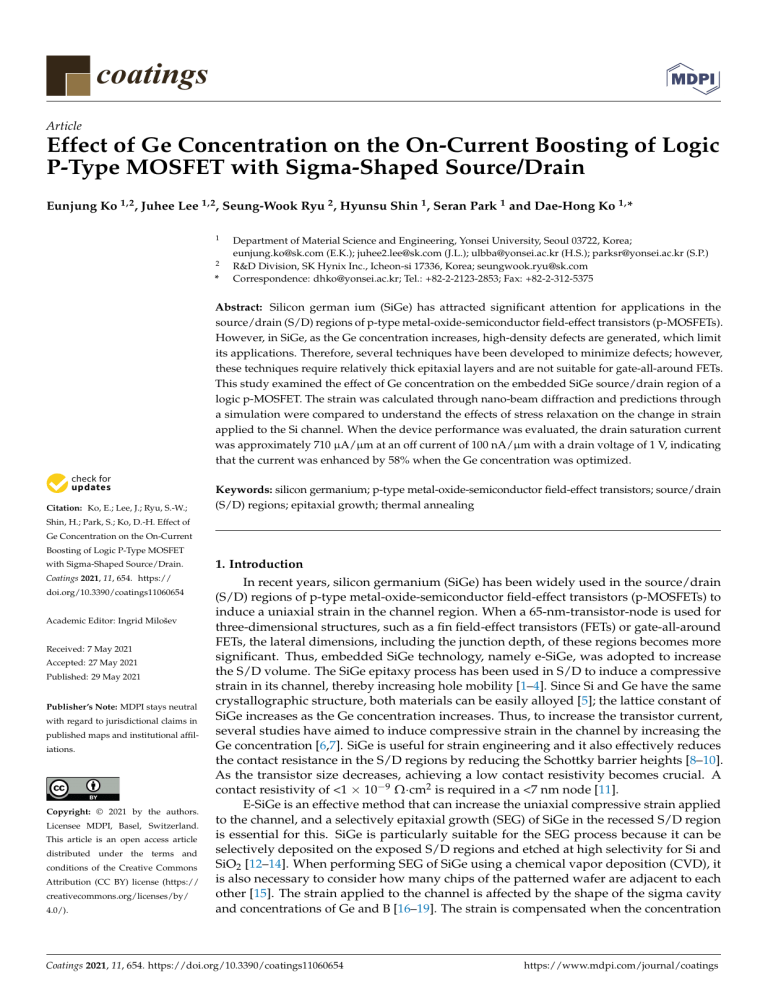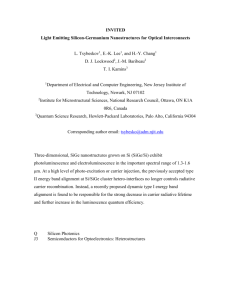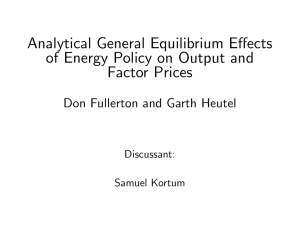
coatings Article Effect of Ge Concentration on the On-Current Boosting of Logic P-Type MOSFET with Sigma-Shaped Source/Drain Eunjung Ko 1,2 , Juhee Lee 1,2 , Seung-Wook Ryu 2 , Hyunsu Shin 1 , Seran Park 1 and Dae-Hong Ko 1, * 1 2 * Department of Material Science and Engineering, Yonsei University, Seoul 03722, Korea; eunjung.ko@sk.com (E.K.); juhee2.lee@sk.com (J.L.); ulbba@yonsei.ac.kr (H.S.); parksr@yonsei.ac.kr (S.P.) R&D Division, SK Hynix Inc., Icheon-si 17336, Korea; seungwook.ryu@sk.com Correspondence: dhko@yonsei.ac.kr; Tel.: +82-2-2123-2853; Fax: +82-2-312-5375 Abstract: Silicon german ium (SiGe) has attracted significant attention for applications in the source/drain (S/D) regions of p-type metal-oxide-semiconductor field-effect transistors (p-MOSFETs). However, in SiGe, as the Ge concentration increases, high-density defects are generated, which limit its applications. Therefore, several techniques have been developed to minimize defects; however, these techniques require relatively thick epitaxial layers and are not suitable for gate-all-around FETs. This study examined the effect of Ge concentration on the embedded SiGe source/drain region of a logic p-MOSFET. The strain was calculated through nano-beam diffraction and predictions through a simulation were compared to understand the effects of stress relaxation on the change in strain applied to the Si channel. When the device performance was evaluated, the drain saturation current was approximately 710 µA/µm at an off current of 100 nA/µm with a drain voltage of 1 V, indicating that the current was enhanced by 58% when the Ge concentration was optimized. Citation: Ko, E.; Lee, J.; Ryu, S.-W.; Keywords: silicon germanium; p-type metal-oxide-semiconductor field-effect transistors; source/drain (S/D) regions; epitaxial growth; thermal annealing Shin, H.; Park, S.; Ko, D.-H. Effect of Ge Concentration on the On-Current Boosting of Logic P-Type MOSFET with Sigma-Shaped Source/Drain. 1. Introduction Coatings 2021, 11, 654. https:// In recent years, silicon germanium (SiGe) has been widely used in the source/drain (S/D) regions of p-type metal-oxide-semiconductor field-effect transistors (p-MOSFETs) to induce a uniaxial strain in the channel region. When a 65-nm-transistor-node is used for three-dimensional structures, such as a fin field-effect transistors (FETs) or gate-all-around FETs, the lateral dimensions, including the junction depth, of these regions becomes more significant. Thus, embedded SiGe technology, namely e-SiGe, was adopted to increase the S/D volume. The SiGe epitaxy process has been used in S/D to induce a compressive strain in its channel, thereby increasing hole mobility [1–4]. Since Si and Ge have the same crystallographic structure, both materials can be easily alloyed [5]; the lattice constant of SiGe increases as the Ge concentration increases. Thus, to increase the transistor current, several studies have aimed to induce compressive strain in the channel by increasing the Ge concentration [6,7]. SiGe is useful for strain engineering and it also effectively reduces the contact resistance in the S/D regions by reducing the Schottky barrier heights [8–10]. As the transistor size decreases, achieving a low contact resistivity becomes crucial. A contact resistivity of <1 × 10−9 Ω·cm2 is required in a <7 nm node [11]. E-SiGe is an effective method that can increase the uniaxial compressive strain applied to the channel, and a selectively epitaxial growth (SEG) of SiGe in the recessed S/D region is essential for this. SiGe is particularly suitable for the SEG process because it can be selectively deposited on the exposed S/D regions and etched at high selectivity for Si and SiO2 [12–14]. When performing SEG of SiGe using a chemical vapor deposition (CVD), it is also necessary to consider how many chips of the patterned wafer are adjacent to each other [15]. The strain applied to the channel is affected by the shape of the sigma cavity and concentrations of Ge and B [16–19]. The strain is compensated when the concentration doi.org/10.3390/coatings11060654 Academic Editor: Ingrid Milošev Received: 7 May 2021 Accepted: 27 May 2021 Published: 29 May 2021 Publisher’s Note: MDPI stays neutral with regard to jurisdictional claims in published maps and institutional affiliations. Copyright: © 2021 by the authors. Licensee MDPI, Basel, Switzerland. This article is an open access article distributed under the terms and conditions of the Creative Commons Attribution (CC BY) license (https:// creativecommons.org/licenses/by/ 4.0/). Coatings 2021, 11, 654. https://doi.org/10.3390/coatings11060654 https://www.mdpi.com/journal/coatings Coatings 2021, 11, 654 2 of 9 ings 2021, 11, x FOR PEER REVIEW of B increases to realize a low contact resistance of S/D. Therefore, increasing the Ge concentration remains crucial in a gate-all-around FET. However, as the Ge concentration increases, high-density defects are generated in the grown layers because the difference in the lattice parameter between the Si substrate and the SiGe layer increases [12,13]. Therefore, several techniques have been developed to minimize defects, such as epitaxial lateral overgrowth [12] and thermal cyclic annealing [13]. However, these techniques require relatively thick epitaxial layers and are not suitable for gate-all-around FETs. Herein, we studied the current boosting and defect generation in a nano-sized sigmashaped SiGe pattern, which was designed to implement the S/D shape in a gate-all-around FET. The strain behavior in the Si channel and the formation of misfit dislocations in SiGe were investigated for various values of concentrations of Ge (CGe ). The strain inside the channel was analyzed using nano-beam diffraction (NBD) and simulation. Furthermore, the change in stress owing to an e-SiGe and its effect on the electrical performance of a 28-nm-p-MOSFET were also evaluated. In this study, intrinsic SiGe was grown in one 3 of 9 sigma cavity structure, but B-doped SiGe will be grown in various sigma cavities in the future to study changes in device characteristics. Methods Finally, the 2. L3Materials layer wasand made of pure Si fabricated using the epitaxy method, which The The CGe L3 effect in acted current by layer SiGe was examined using a p-MOSFET device capped the L2 layer. layer as boosting a sacrificial to supply the necessary Si for a planar gatecontact structure. A multilayer comprising layer 1hole (L1)/layer forming thewith silicide-reduced resistance in the SiGe, S/D region. To supply carriers2 (L2)/layer 3 (L3),boron was formed using the process flow shown in Figure 1a of after sigma in the S/D region, was incorporated in situ at doping concentrations lessa than 1 cavity was 19 20 3 to implement theand S/DL2, shape in a gate-all-around The CGe distribution in SiGe × 10 and 2created × 10 atoms/cm in L1 respectively. After the FET. native oxide was rewas in confirmed a transmission electron microscopy-energy dispersive moved through situ dry using cleaning, the L1, L2, and L3 layers were epitaxially grown byX-ray (TEMEDX, X-MAX vapor 80 TLEdeposition detector, Oxford , Abingdon, atomic probe tomography remote plasma chemical without a vacuumEngland) break, asand shown in Figure (APT, CAMECA, Gennevilliers, France). in the 1d. The SiGe or SiLEAP5000XR, epitaxial layers of L1, L2, and L3 were grown The usingmisfit SiCl2dislocations H2 (disigma-shaped cavity of the e-SiGe S/D region were analyzed using high-resolution TEM chlorosilane, DCS) and GeH4 as precursors, and the selectivity was determined by co(HR-TEM, JEM2100F, JEOL, Tokyo, Japan). The strain induced in the channel was calculated flowing HCl gas [23–25]. L1, L2, and L3 were grown at 660, 620, and 750 °C, respectively. using a fast Fourier transform image obtained through thecavities nano-beam diffraction (NBD) The fabricated MOSFETs showed uniformly patterned sigma-shaped in the S/D and simulated using ANSYS 10, software (version 19, the ANSYS, Workbench, region with method critical dimensions of approximately 30, and 30 nm for top, center, and PA, USA). electrical properties of the in p-MOSFETs were L1 characterized a semiconductor depth of theThe cavity, respectively, as shown Figure 1e. Both and L2 wereusing uniformly parameter analyzer B1500A, CA, USA). grown at different growth rates (Agilent, induced by the crystal plane of the Si substrate [26]. Figure 1. (a) The process schematic structure at each step.at(b) Anisotropic Si etch through dry etching using Figure 1. (a)flow The and process flow and schematic structure each step. (b) Anisotropic Si etch through HBr, Cl2 , He. dry (c) etching The sigma-shaped cavity formed through cavity wet etching. (d) Multilayer SiGe epitaxial using HBr, Cl 2, He. was (c) The sigma-shaped was formed through wet etching. (d) growth. Multilayer SiGe epitaxial (e) Cross-sectional TEM image after SiGegrowth. growth.(e) Cross-sectional TEM image after SiGe growth. Results Discussion Figure 23.shows theand vertical and longitudinal distributions of CGe in SiGe, as measured using TEM-EDX.Figure The x-axis in Figure 2a,b correspond to the in red blue dots, respec- a strain in 1 shows the formation of sigma cavity theand transistor for inducing tively, in thethe inset of Figure 2a. Ge was not detected at vertical positions 1 and 2, indicating Si channel. After the Si was anisotropically patterned through dry etching, as shown that they corresponded Si substrate.cavity, At vertical position 3, CGe was approximately in Figure 1b,toathe sigma-shaped as shown in Figure 1c, was formed at an angle of 22.6 at.%–28.5 whichthe increased to approximately at.%–36.6 at.% at vertical posi-ammonium 54◦at.%, through anisotropic etching of the30.2 Si (111) plane with tetramethyl tion 5. It fluctuated between 51 at.% and 61 at.% at vertical positions 6–9, and then dropped steeply to 0 at.% at vertical positions 11 and 12. This indicates that L1, L2, and L3 were formed cleanly without any intermixing between L1 and L3. In the longitudinal direction, CGe was distributed across the five regions. Regions I and V had CGe of 0 at.%, which indicates that these corresponded to the Si substrate. In regions II and IV, CGe was Coatings 2021, 11, 654 3 of 9 hydroxide (TMAH) [20,21], which directly affects the electrical performance, especially the on-current [22]. To understand the intrinsic CGe effect of SiGe, a sigma cavity was created through minimization in the range of 3-sigma (0.67%), which could minimize the variation in the sigma cavity shape. L1, L2, and L3 were grown on a sigma-shaped cavity and they played different roles, as shown in Figure 1d. L1 was a buffer layer with a relatively low CGe of 25 at.%, which improved the poor coverage of the sigma-shaped cavity; this originated from the low growth rate of the Si (100) plane, caused by the narrow width of the bottom layer. In addition, L1 suppressed the strain relaxation due to the lattice mismatch between the Si substrate and L2 and the punch between the source and the drain. L2 possessed a relatively high CGe of 50 at.%–60 at.% and was epitaxially grown as a main stressor. This layer induced a strong compressive strain in the channel because of the lattice mismatch originating from its high CGe , which, in turn, boosted the channel current. Finally, the L3 layer was made of pure Si fabricated using the epitaxy method, which capped the L2 layer. The L3 layer acted as a sacrificial layer to supply the necessary Si for forming the silicide-reduced contact resistance in the S/D region. To supply hole carriers in the S/D region, boron was incorporated in situ at doping concentrations of less than 1 × 1019 and 2 × 1020 atoms/cm3 in L1 and L2, respectively. After the native oxide was removed through in situ dry cleaning, the L1, L2, and L3 layers were epitaxially grown by remote plasma chemical vapor deposition without a vacuum break, as shown in Figure 1d. The SiGe or Si epitaxial layers of L1, L2, and L3 were grown using SiCl2 H2 (dichlorosilane, DCS) and GeH4 as precursors, and the selectivity was determined by co-flowing HCl gas [23–25]. L1, L2, and L3 were grown at 660, 620, and 750 ◦ C, respectively. The fabricated MOSFETs showed uniformly patterned sigma-shaped cavities in the S/D region with critical dimensions of approximately 10, 30, and 30 nm for the top, center, and depth of the cavity, respectively, as shown in Figure 1e. Both L1 and L2 were uniformly grown at different growth rates induced by the crystal plane of the Si substrate [26]. Figure 2 shows the vertical and longitudinal distributions of CGe in SiGe, as measured using TEM-EDX. The x-axis in Figure 2a,b correspond to the red and blue dots, respectively, in the inset of Figure 2a. Ge was not detected at vertical positions 1 and 2, indicating that they corresponded to the Si substrate. At vertical position 3, CGe was approximately 22.6 at.%–28.5 at.%, which increased to approximately 30.2 at.%–36.6 at.% at vertical position 5. It fluctuated between 51 at.% and 61 at.% at vertical positions 6–9, and then dropped steeply to 0 at.% at vertical positions 11 and 12. This indicates that L1, L2, and L3 were formed cleanly without any intermixing between L1 and L3. In the longitudinal direction, CGe was distributed across the five regions. Regions I and V had CGe of 0 at.%, which indicates that these corresponded to the Si substrate. In regions II and IV, CGe was distributed between 20 at.% and 26 at.%, and in region III, CGe was 46.9 at.%, 54.6 at.%, and 58.7 at.%. To precisely determine CGe , APT was used to analyze the sigma-shaped cavity, which included L2 with CGe = 55 at.%. This region is marked by white dots, as shown in the inset of Figure 2a. Although the data are not shown, CGe was 57.22 at.%, which is similar to the results obtained by TEM-EDX. The change in strain due to variations in CGe in L2 was evaluated according to the misfit dislocations and NBD analysis. Coatings 2021, 11, x FOR PEER REVIEW Coatings 2021, 11, 654 4 of 9 Figure 2. CGe distribution for (a) vertical and (b) longitudinal direction of CGe = 50, 55, and 60 at.% Figure 2.L2. CGe distribution for (a) vertical and (b) longitudinal direction of CGe = 50, 55 in SiGe of in SiGe of L2. Figure 3 shows the simulated strain map of L2 in the p-MOSFETs for various CGe . The strain is expressed as a normalized value because the material properties set for the Figure shows thecoincide simulated strain map ofThe L2compressive in the p-MOSFETs simulation did3not precisely with the actual films. and tensile for va stressesis areexpressed represented as by a negative and positive values, respectively. A negative strain strain normalized value because the material properties se was generated below the tip of the sigma-shaped cavity and applied to the Si channel. ulation did not precisely coincide with the actual films. The compressiv In addition, the regimen of generated negative strain widened with increasing CGe in L2. stresses are represented byshifted negative and positive respectively. Finally, the strain in the channel to a negative value withvalues, an increase in the CGe . A n This implies that the negative increased the compressivecavity stress inand the Si channel.to the was generated below thestrain tip of the sigma-shaped applied Thus, increasing the CGe should boost the current by inducing the addition, the regimen of generated negative straincompressive widenedstress withinincreasing Si channel. nally, the strain in the channel shifted to a negative value with an increase in implies that the negative strain increased the compressive stress in the Si c increasing the CGe should boost the current by inducing compressive stress i nel. Coatings2021, 2021,11, 11,x654 Coatings FOR PEER REVIEW 5 5ofof99 Figure Figure3.3.Simulated Simulatedstrain strainmaps mapsfor for(a) (a)CCGeGe= =5050at.%, at.%,(b) (b)5555at.% at.%and and(c)(c)6060at.% at.%ininSiGe SiGeofofL2L2. To actual strain of of thethe Si channel, the the strain was was measured at five Toverify verifythe thechange changeinin actual strain Si channel, strain measured at points through NBDNBD analysis, as marked by red in the inset of Figure 4a. 4a. TheThe Si five points through analysis, as marked by circles red circles in the inset of Figure channel with thethe e-SiGe S/DS/D region, including L2 at displayed a strain of Si channel with e-SiGe region, including L2CatGeC=Ge50=at.%, 50 at.%, displayed a strain of approximately −0.44% the center Thisremained value remained almost constant approximately −0.44% at theatcenter (point(point 3). This3).value almost constant regardregardless of the measurement position. When to 55 the strain less of the measurement position. When the CGe the wasCincreased to 55 at.%, theat.%, strain shifted Ge was increased shifted to approximately 1.02%. This indicates that the compressive stress induced by to approximately −1.02%. − This indicates that the compressive stress induced by the exthe extended S/D was effectively the Si channel, theincreased stress increased tended S/D was effectively appliedapplied to the Sitochannel, and theand stress with anwith inan increased in L2. Theinstrain the Si channel L2= for CGe = 55 at.%a showed creased CGe in C L2. strain the Siinchannel at L2 forat CGe 55 at.% showed parabolica Ge The parabolic distribution with the highest value 3. at This position 3.can This can betoattributed distribution with the highest value at position value bevalue attributed the symto the symmetric placement of the S/D [27]. However, when the C in L2 was increased metric placement of the S/D [27]. However, when the CGe in L2 wasGeincreased to 60 at.%, to 60 at.%,became the strain less negative, i.e., the applied stress Thus, decreased. Thus, the the strain lessbecame negative, i.e., the applied stress decreased. the number of number of misfit dislocations counted verify in thestress change in stresswith relaxation with misfit dislocations was countedwas to verify thetochange relaxation increasing CGeshown in L2, as Figure 4b. The number of dislocations misfit dislocations generated for Cincreasing Ge in L2, as in shown Figure in 4b. The number of misfit generated for 100 100 sigma-shaped cavities evaluated statistically organized. L2 with 50 at.%, sigma-shaped cavities waswas evaluated andand statistically organized. L2 with CGeC=Ge 50=at.%, 55 55 at.%, and 60 at.% showed 2.10, 6.15, and 21.05 misfit dislocations with standard deat.%, and 60 at.% showed 2.10, 6.15, and 21.05 misfit dislocations with standard deviations viations of 1.25, 1.90,respectively. and 5.27, respectively. This indicates thatinanCGe increase in CGe is of 1.25, 1.90, and 5.27, This indicates that an increase is accompanied accompanied by local stress relaxation. In addition, the misfit dislocations were not generby local stress relaxation. In addition, the misfit dislocations were not generated linearly ated linearly with increasing C . The steep increase in the number of misfit dislocations Ge with increasing CGe. The steep increase in the number of misfit dislocations between CGe = between CGe60= at.% 55 at.% and 60 aat.% indicates critical CGe of approximately 55 for at.%–60 at.% 55 at.% and indicates critical CGe ofa approximately 55 at.%–60 at.% relaxing forstress relaxing the stress induced SiGe and Si. The abovementioned results reveal the induced between SiGebetween and Si. The abovementioned results reveal that the strain that the strain induced in the Si channel can be maximized by optimizing the C with Ge induced in the Si channel can be maximized by optimizing the CGe with respect to stress respect to stress generation and relaxation. generation and relaxation. Coatings 2021, 11, 654 6 of 9 Figure 4. (a) Strain distributions measured for various CGe in SiGe of L2 by NBD analysis and (b) the number of misfit dislocation included in L2 (counted for 100 sigma cavities and statistically calculated). To determine the effect of the changes in stress on the electrical performance of the p-MOSFET, electrical properties, such as the off current (Ioff ) and drain saturation current (Idsat ), were evaluated. The p-MOSFET with L2 (CGe = 25 at.%) was used as a reference for comparison with the p-MOSFETs having the e-SiGe S/D regions. Figure 5 shows that Idsat = 450 µA/µm was obtained at Ioff = 100 µA/µm with a drain voltage (V DD ) of 1 V for the reference p-MOSFET. For L2 layers with CGe = 50 at.% and 55 at.%, Idsat values of approximately 710 µA/µm were obtained; this indicates an improvement of approximately 58%. However, Idsat decreased to 620 µA/µm when the CGe in L2 was increased to 60 at.%. Coatings 2021, 11, 654 7 of 9 Coatings 2021, 11, x FOR PEER REVIEW 7 of 9 This tendency coincides with the change in strain with increasing CGe in L2, as shown in Figurecoincides 4a. Thiswith shows that increasing the local compressive strain should be tendency the strong changeevidence in strain with CGe in L2, as shown in Figure maximized bystrong increasing the Cthat in L2 to suppress stress relaxation and boost the current 4a. This shows evidence the local compressive strain should be maximized by Ge in the channel. increasing the CGe in L2 to suppress stress relaxation and boost the current in the channel. Figure 5. I versus Idsat for 28-nm-logic p-MOSFET with various CGe of L2 in SiGe of embedded S/D. Figure 5. Ioffoffversus Idsat for 28-nm-logic p-MOSFET with various CGe of L2 in SiGe of embedded S/D. 4. Conclusions In this work, SiGe was grown by the epitaxy method with various CGe s in L2 through 4. Conclusions remote plasma CVD. The effect of varying CGe for L2 in the sigma-shaped cavity for the this work, SiGe was grown bywas thequantitatively epitaxy method with various CGes TEM-EDX in L2 through S/DInregion of a 28-nm-p-MOSFET investigated using and remote plasma CVD. The effect of varying C Ge for L2 in the sigma-shaped cavity fora the APT. The different layers of e-SiGe were clearly defined, and the L2 layer possessed CGe S/D region of aat.%. 28-nm-p-MOSFET quantitatively investigated using TEM-EDX of 50 at.%–60 The simulatedwas strain map showed that the strain near the tip ofand the APT. The different layers e-SiGefocused were clearly defined, and thethe L2Clayer possessed a CGe sigma-shaped cavity wasoflocally and increased with Ge in L2. In contrast, ofthe 50measured at.%–60 at.%. The simulated strain map showed thatthat thethe strain near the tip ofwhen the strain in the sigma-shaped cavity revealed strain decreased in formation L2. In contrast, the sigma-shaped locally focused andrelaxation increasedcaused with thebyCGe CGe = 60 at.%cavity in L2 was owing to local stress the of misfit measured strain in the sigma-shaped cavity decreased when CGethe = dislocations. The change in Ioff caused by revealed a changethat in Ithe strongly coincided with dsat strain 60 at.% ininL2local owing to local stress relaxation the clearly formation of misfit change strain with increasing CGecaused in L2. by This verifies thatdislocations. the channel The change causedbybymaximizing a change inthe IdsatCstrongly coincided with the stress change in local current canin beIoff boosted to suppress local relaxation, Ge in SiGe strain with increasing CGe in L2. This clearly verifies that the channel current can be thus resulting in the formation of misfit dislocations. boosted by maximizing the CGe in SiGe to suppress local stress relaxation, thus resulting Contributions: Conceptualization, inAuthor the formation of misfit dislocations. E.K.; methodology, H.S. and S.P.; software, E.K.; formal analysis, J.L.; writing—original draft preparation, E.K.; writing—review and editing, S.W.R.; supervision, D.-H.K.; funding acquisition, D.-H.K. All authors have readH.S. andand agreed the published version Author Contributions: Conceptualization, E.K.; methodology, S.P.;tosoftware, E.K.; formal of the manuscript. analysis, J.L.; writing—original draft preparation, E.K.; writing—review and editing, S.W.R.; supervision, D.-H.K.; funding acquisition, D.-H.K. All authors have read and agreed to the published Funding: This work was supported by the Technology Innovation Program (20010598) funded by the version of the manuscript. Ministry of Trade, Industry & Energy (MOTIE) and Future Semiconductor Device Technology Development Program (10067739) funded by by the MOTIE and Korea Semiconductor Research Consortium Funding: This work was supported Technology Innovation Program (1415173045) funded (KSRC). by the Ministry of Trade, Industry & Energy (MOTIE) and Future Semiconductor Device Technology Development Program (10067739) funded by the MOTIE and Korea Semiconductor Research Institutional Review Board Statement: Not applicable. Consortium (KSRC). Informed Consent Statement: Not applicable. Institutional Review Board Statement: Not applicable. Data Availability Statement: All the original data generated in this research are available. Informed Consent Statement: Not applicable. Conflicts of Interest: The authors declare no conflict of interest. Data Availability Statement: All the original data generated in this research are available. Conflicts of Interest: The authors declare no conflict of interest. References Coatings 2021, 11, 654 8 of 9 References 1. 2. 3. 4. 5. 6. 7. 8. 9. 10. 11. 12. 13. 14. 15. 16. 17. 18. 19. 20. 21. 22. 23. 24. 25. Fischetti, M.V.; Laux, S.E. Band Structure, Deformation Potentials, and Carrier Mobility in Strained Si, Ge, and SiGe Alloys. J. Appl. Phys. 1996, 80, 2234–2252. [CrossRef] Thompson, S.E.; Armstrong, M.; Auth, C.; Alavi, M.; Buehler, M.; Chau, R.; Cea, S.; Ghani, T.; Glass, G.; Hoffman, T.; et al. A 90-Nm Logic Technology Featuring Strained-Silicon. IEEE Trans. Electron Dev. 2004, 51, 1790–1797. [CrossRef] Yeo, Y.-C. Enhancing CMOS Transistor Performance Using Lattice-Mismatched Materials in Source/Drain Regions. Semicond. Sci. Technol. 2007, 22, S177–S182. [CrossRef] Chu, M.; Sun, Y.; Aghoram, U.; Thompson, S.E. Strain: A Solution for Higher Carrier Mobility in Nanoscale MOSFETs. Annu. Rev. Mater. Res. 2009, 39, 203–229. [CrossRef] Bedell, S.W.; Khakifirooz, A.; Sadana, D.K. Strain Scaling for CMOS. Mrs Bull. 2014, 39, 131–137. Chidambaram, P.R.; Smith, B.A.; Hall, L.H.; Bu, H.; Chakravarthi, S.; Kim, Y.; Samoilov, A.V.; Kim, A.T.; Jones, P.J.; Irwin, R.B.; et al. 35% drive current improvement from recessed-SiGe drain extensions on 37 nm gate length PMOS. In Proceedings of the Digest of Technical Papers Symposium on VLSI Technology, Honolulu, HI, USA, 15–17 June 2004; p. 48. Ghani, T.; Armstrong, M.; Auth, C.; Bost, M.; Charvat, P.; Glass, G.; Hoffmann, T.; Johnson, K.; Kenyon, C.; Klaus, J.; et al. A 90 nm high volume manufacturing logic technology featuring novel 45 nm gate length strained silicon CMOS transistors. In Proceedings of the IEEE International Electron Devices Meeting, Washington, DC, USA, 8–10 December 2003; pp. 978–980. Sarangapani, P.; Weber, C.; Chang, J.; Cea, S.; Povolotskyi, M.; Klimeck, G.; Kubis, T. Atomistic Tight-Binding Study of Contact Resistivity in Si/SiGe PMOS Schottky Contacts. IEEE Trans. Nanotechnol. 2018, 17, 968–973. [CrossRef] Zhang, J.; Yu, H.; Schaekers, M.; Horiguchi, N.; Wang, L.-L.; Jiang, Y.-L. Observation of contact resistivity independence from schottky barrier height on heavily doped p-type SiGe. In Proceedings of the IEEE International Conference on Solid-State and Integrated Circuit Technology (ICSICT), Hangzhou, China, 25–28 October 2016. Sarangapani, P.; Weber, C.; Chang, J.; Cea, S.; Golizadeh-Mojarad, R.; Povolotskyi, M.; Klimeck, G.; Kubis, T. Assessment of Si/SiGe PMOS schottky contacts through atomistic tight binding simulations: Can we achieve the 10−9 Ω·cm target? In Proceedings of the 17th International Conference Nanotechnol, Pittsburgh, PA, USA, 25–28 July 2017. Ni, C.-N.; Rao, K.V.; Khaja, F.; Sharma, S.; Tang, S.; Chen, J.J.; Hollar, K.E.; Breil, N.; Li, X.; Jin, M.; et al. Ultra-low NMOS contact resistivity using a novel plasma-based DSS implant and laser anneal for post 7 nm nodes. In Proceedings of the 2016 IEEE Symposium on VLSI Technology, Honolulu, HI, USA, 14–16 June 2016. Kazi, Z.I.; Thilakan, P.; Egawa, T.; Umeno, M.; Jimbo, T. Realization of GaAs/AlGaAs Lasers on Si Substrates Using Epitaxial Lateral Overgrowth by Metalorganic Chemical Vapor Deposition. Jpn. J. Appl. Phys. 2001, 40, 4903–4906. [CrossRef] Hayafuji, N.; Miyashita, M.; Nishimura, T.; Kadoiwa, K.; Kumabe, H.; Murotani, T. Effect of Employing Positions of Thermal Cyclic Annealing and Strained-Layer Superlattice on Defect Reduction in GaAs-On-Si. Jpn. J. Appl. Phys. 1990, 29, 2371–2375. [CrossRef] Li, J.; Wang, W.; Li, Y.; Zhou, N.; Wang, G.; Kong, Z.; Fu, J.; Yin, X.; Li, C.; Wang, X.; et al. Study of Selective Isotropic Etching Si1−x Gex in Process of Nanowire Transistors. J. Mater. Sci. Mater. Electron. 2020, 31, 134. [CrossRef] Kolahdouz, M.; Maresca, L.; Ostling, M.; Riley, D.; Wise, R.; Radamson, H.H. New Method to Calibrate the Pattern Dependency of Selective Epitaxy of SiGe Layers. Solid State Electron. 2009, 53, 858–861. [CrossRef] Schmidt, M.; Minamisawa, R.A.; Richter, S.; Luptak, R.; Hartmann, J.M.; Buca, D.; Zhao, Q.T.; Mantl, S. Impact of Strain and Ge Concentration on the Performance of Planar SiGe Band-to-Band-Tunneling Transistors. Ultim. Integr. Silicon 2011, 71, 42–47. Qin, C.; Yin, H.; Wang, G.; Hong, P.; Ma, X.; Cui, H.; Lu, Y.; Meng, L.; Yin, H.; Zhong, H.; et al. Study of Sigma-Shaped Source/Drain Recesses For Embedded-SiGe pMOSFETs. Microelectron. Eng. 2017, 181, 22–28. [CrossRef] Wang, G.; Luo, J.; Qin, C.; Liang, R.; Xu, Y.; Liu, J.; Li, J.; Yin, H.; Yan, J.; Zhu, H.; et al. Integration of Highly Strained SiGe in Source and Drain with HK and MG for 22 nm Bulk PMOS Transistors. Nanoscale Res. Lett. 2017, 12, 123. [CrossRef] [PubMed] Hållstedt, J.; Kolahdouz, M.; Ghandi, R.; Radamson, H.H.; Wise, R. Pattern Dependency in Selective Epitaxy of B-doped SiGe Layers for Advanced Metal Oxide Semiconductor Field Effect Transistors. J. Appl. Phys. 2008, 103, 054907. [CrossRef] Tokoro, K.; Uchikawa, D.; Shikida, M.; Sato, K. Anisotropic etching properties of silicon in KOH and TMAH solutions. In Proceedings of the MHA0 98 Proceedings of the 1998 International Symposium on Micromechatronics and Human Science— Creation of New Industry, Nagoya, Japan, 25–28 November 1998; p. 65. Cheng, D.; Gosálvez, M.A.; Hori, T.; Sato, K.; Shikida, M. Improvement in Smoothness of Anisotropically Etched Silicon Surfaces: Effects of Surfactant and TMAH Concentrations. Sens. Actuators A 2006, 125, 415–421. [CrossRef] Lo, H.-C.; Peng, J.; Reis, E.; Zhu, B.; Ma, W.; Mun, S.Y.; Shintri, S.; Bazizi, E.M.; Gaire, C.; Qi, Y.; et al. A Novel Approach to Control Source/Drain Cavity Profile for Device Performance Improvement. IEEE Trans. Electron Devices 2018, 65, 3640–3645. [CrossRef] Loo, R.; Caymax, M.; Meunier-Beillard, P.; Peytier, I.; Holsteyns, F.; Kubicek, S.; Verheyen, P.; Lindsay, R.; Richard, O. A New Technique to Fabricate Ultra-Shallow-Junctions, Combining in Situ Vapour HCl Etching and in Situ Doped Epitaxial SiGe Re-Growth. Appl. Surf. Sci. 2004, 224, 63–67. [CrossRef] Kolahdouz, M.; Maresca, L.; Ghandi, R.; Khatibi, A.; Radamson, H.H. Kinetic Model of SiGe Selective Epitaxial Growth Using RPCVD Technique. J. Electrochem. Soc. 2011, 158, H457. [CrossRef] Radamson, H.H.; Kolahdouz, M. Selective Epitaxy Growth of Si1−x Gex Layers for MOSFETs and FinFETs. J. Mater. Sci. Mater. Electron. 2015, 26, 4584. [CrossRef] Coatings 2021, 11, 654 26. 27. 9 of 9 Rosseel, E.; Profijt, H.B.; Hikavyy, A.Y.; Tolle, J.; Kubicek, S.; Mannaert, G.; L’abbe, C.; Wostyn, K.; Horiguchi, N.; Clarysse, T.; et al. Characterization of Epitaxial Si:C:P and Si:P Layers for Source/Drain Formation in Advanced Bulk FinFETs. ECS Trans. 2014, 64, 977–987. [CrossRef] Maeda, S.; Ko, Y.; Jeong, J.; Fukutome, H.; Kim, M.; Kim, S.; Choi, J.; Shin, D.; Oh, Y.; Lim, W.; et al. 3 Dimensional scaling extensibility on epitaxial source drain strain technology toward fin fet and beyond. In Proceedings of the 2013 Symposium on VLSI Technology, Kyoto, Japan, 11–13 June 2013.





